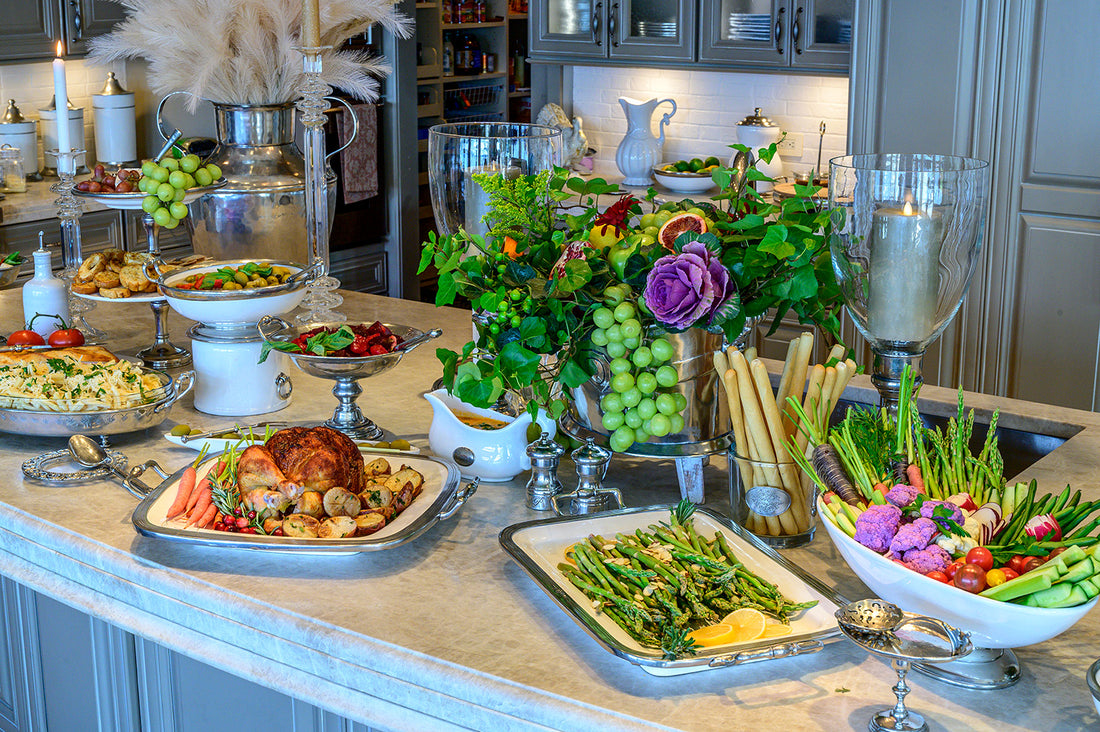Presenting your meal buffet-style is a wonderful way to serve a large group of people in your dining room or to create a beautiful focal point for a more casual get-together like a baby shower or Christmas mixer. We're sharing all our ideas for:
- ● Gorgeous and practical food presentation,
- ● What order to place your dishes on the table,
- ● How to serve drinks,
- ● Calculating food portions, and
- ● How best to position each course of your meal.
Gather and Graze: The Allure of Buffet-Style Feasts
Are you planning a large gathering of people where a sit-down dinner with food on the table just doesn't make sense? Placing your serving dishes on a sideboard buffet-style is a great way to make extra room at the dining table for more guests! It's also a wonderful way to serve food at an event where people want to take their plates and mingle for a few hours, rather than sit down for a formal meal as the main focus.

Setting the Stage: Choosing the Right Buffet Table
The first thing to think about is the buffet itself. This is the base of everything that is to come! Some people like to use a tablecloth, table square, or table runner that complements the color scheme of the rest of the party decor or the room. However, if the sideboard, table, or buffet itself is beautiful all on its own, we recommend leaving it as-is. This will make spills less stressful for your guests and easier for you to quickly clean up. Do what seems best for your space.
Food for Thought: Deciding What and How Much to Serve
Then, it's time to choose the food you want to offer your guests, as this will influence the serving arrangements. Once you decide on WHAT you want to serve, it is very important to decide HOW MUCH of each dish you need to make or order, since too little food is catastrophic in a dinner party situation but too much food is wasteful and appears gluttonous.

Here is a good rule of thumb for how much to serve per person for each course:
- ● Salad: about 1 cup
- ● Soup: also about 1 cup
- ● Bread: 1-3 pieces
- ● Appetizers: 6-8 small pieces
- ● Main courses (meat or other protein): 4-6 oz
- ● Side dishes: offer 2-3 side dishes and plan for 4-6 oz each per person
- ● Dessert: single serve is easiest! If you plan to offer a variety, plan for 1-2 or 2-3 each, depending on the size of each piece.
- ● Beverages: 2-3 drinks per person, and it is advised to offer a mix of alcoholic and non-alcoholic.
Buffet Ballet: Choreographing a Graceful Flow of Food and Guests
Then, you must set up your buffet so that traffic to and from the food flows naturally and does not interrupt your guests' laughter and conversation as they fill their plates and return to the table. You want to avoid any collisions or confusion! A properly ordered buffet is a thing of beauty in its own right. The easiest way to set up a buffet table properly is by setting out your dishes in the order they will be eaten. This ensures that your guests don't suddenly realize they have to go backwards to grab something they forgot or didn't see, which of course interrupts the food service flow.
Start with your cutlery, napkins, bread, and bread plates. If you are planning a salad course, this should go next. If soups are also offered, soup bowls, spoons, and the soups themselves follow. Starters should then be presented. Next, it is time to present the main course.
Buffet Brilliance: Mastering the Art of Placement and Presentation
You need to make sure you consider everything that will make your buffet beautiful, functional, and safe. The best way to make sure you consider everything is to do a dry run! Gather all the serving plates and dishes you will be using a few days before your next party and run through the following list, moving dishes around as you play with what works best.

1. Large vs. small dishes
Consider placing the large main course dishes toward the back of your serving table. This will create a balanced look that does not appear "top-heavy" to your guests, as a front-loaded table might. This placement will also allow easy labeling of the dishes most likely to need explanation. Because they are heavy, it is best to leave your main courses flat on the table. Use a beautiful spoon rest in front of each dish that requires serving utensils, which will protect your buffet surface and lend an air of elegance to your dinner party.

2. Side dishes
Hors d'oeuvres, side dishes, sauces, dips, and breads are where you can really get creative with your table display! These food offerings are more likely to be placed in and on lightweight and pretty serving platters, dishes, bowls, and trays. Use this to your table's advantage.
Small plates should be displayed at different heights to create interest and variation. This can be done by placing a stack of books under them (especially if you are using a tablecloth), but we prefer using beautiful serving ware designed for this purpose. Cake stands can be repurposed to hold appetizers, for example. Any other type of tiered plate with different levels is a great option too.

Make sure to place your sides and other complementary dishes close to the main course they are meant to be enjoyed with. For example, make sure your gravy boat is close to the roast beef and potatoes, and that your delicious homemade dressing and oils are located close to the green salads.
All these details are not only visually appealing, but incredibly practical for your guests as well.
3. Food temperature
When placing your dishes in your dry run days before your actual feast, make sure you keep in mind that cold food and hot food should be separated. Since it is important in terms of food safety that hot food stays hot and cold food stays cold, you don't want these dishes touching each other and lowering or raising the temperature too much.
One great idea to prevent this from happening is to serve your hot dishes in something insulated or with a lid to keep the heat from spreading. Be careful not to place something delicate like French bread or salad greens close to anything that might ruin them with steam.

4. Food stations
Consider a separate, small table for drinks, set up at some distance to the side of the buffet.
Beverage dispensers take up a considerable amount of real estate and can cause crowding if you try and set them up at the end of the table instead of on their own. Often, your guests will want to refill their drinks without taking more food, and having to navigate the food table can cause longer waits or traffic jams.

We recommend placing any punch bowls or other dispensers, cups, wine glasses, and ice buckets on their own table.
You might also want to consider setting up a separate station for coffee and tea and all that is required to serve these hot beverages. Coffee and tea are usually reserved for post-dinner consumption, and making sure they are not in the way while guests fill their plates is another way to keep the flow of traffic moving smoothly.
Sweet treats also deserve their own place of honor! Consider adding a dessert table to your food station ensemble. Just like coffee and tea, your guests are likely to visit the dessert section after dinner and more than once (or twice!). Put your dessert plates and any special cutlery needed either on this separate table or gathered all together at the end of your buffet table as the perfect way to end your meal.
5. Labeling
Once you are confident that your dishes all have the right home on the table, you can place labels close to the dishes that need them. Labeling alcoholic and non-alcoholic beverages might be a good idea. Or, indicating which dish is vegetarian and which contains meat might be essential for some groups. Labels might not always be completely necessary, but if done correctly they can be a beautiful finishing touch or decoration.
6. Decorations
Your beautiful dishes and their interesting presentation will be the main form of decoration for your buffet table! But you can make it even more beautiful with a few simple finishing touches once you are sure that everything else is in place.
Consider sprinkling flower petals that complement your dinner party's color palette between dishes. Faux foliage or real greenery can also go a long way to ensure your table looks decorated and complete even without a tablecloth. You can use a gorgeous vase of flowers to balance an empty space or provide needed height too. To avoid crowding the food and creating a cluttered-looking table, we recommend a light touch with decorations so your dishes can speak for themselves.

Memories Served: Celebrating the Success of Your Well-Planned Buffet Party
And just like that, you have a blueprint for a perfect dinner party that will be the talk of the town! If you give yourself enough time to plan your food presentation and make sure you consider all the variables and steps given here, you are sure to put together a successful buffet table that will be a memorable experience for your guests. Your own creativity paired with some gorgeous serving ware is guaranteed to be a winning combination.

Bon appetit!

